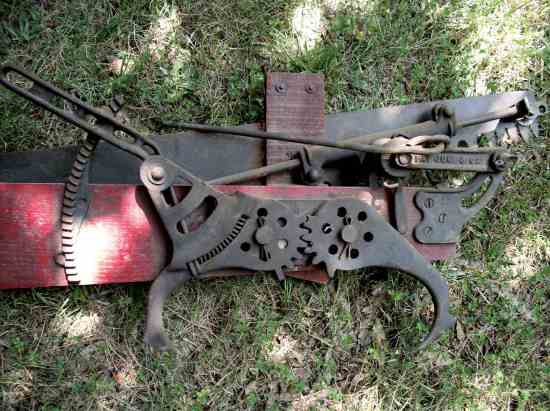In the 1980s I was at a tool auction in Macomb, Ill., when an odd-looking saw came up for auction. At the time I did not know much about it, except that it was different. As luck would have it, I won the bid for about $90.
I took the saw home and used it to saw several logs. I have also felled a tree or two with it. When we had Pioneer Day at the school where I taught, my fourth grade class learned and performed many of the crafts and household jobs the way they were done in the late 1800s. I found students as young as age 10 could use the saw to do the same work I did with it.
I have since searched for information on the folding saw. The device is really a “one-man, two-man saw,” meaning one man operates it, but it saws and cuts like a two-man saw.
Manufactured by Folding Sawing Machine Co., Chicago, the folding saw was originally patented in 1882, patent no. 266,650. It was offered in two sizes. The No. 1 was capable of sawing trees and logs up to a diameter of 4 feet; the No. 2, a larger size, could be used to saw trees and logs from 30 inches to 5-1/2 feet in diameter.
Rare catalog tells the story
Considerable information on this saw was found in an 1896 catalog reprinted by the Mid-West Tool Collectors Assn. in February 1981. The catalog included an illustration of the factory in Chicago. It also showed illustrations of the device set up for use in various positions and types of cutting. It included descriptions and parts lists for both models. Finally, it included several testimonials dating from 1887 through 1896.
The No. 1 unit was available with blades measuring 5-1/2, 6 and 6-1/2 feet. The No. 2 had the same options; a 7-foot blade was also available. The teeth came in three patterns: lance, diamond and champion. The No. 1 saw with 5-1/2-foot blade sold for $15 (about $357 today); No. 1 with 6-foot blade, $15.30; and No. 1 with 6-1/2-foot blade, $15.60. With the same blade options, the No. 2 saw was priced at $18, $18.50 and $19; a unit with a 7-foot blade sold for $19.50.
Designed to be handy
Each saw was made of 61 parts: one blade, seven wooden (white ash) parts and 53 metal parts. Every part, wood or metal, was guaranteed for one year against defect or breakage. When assembled with a 5-1/2-foot blade, the No. 1 unit weighed 41 pounds and the No. 2 weighed 45 pounds. It folded to a bundle measuring about 4 to 5 inches wide and the length of the blade.
In use, the saw could be carried into the woods by resting it on your shoulder. In later years it was offered with a handle attached to the main board. When you arrived at the tree to be cut, the saw was set up to cut the tree perfectly square at any distance from 4-1/2 inches to 27 inches above the ground; legs could be adjusted for use on flat or hilly ground, giving the same square cut. Then you were ready to cut the tree, inserting wedges behind the blade as you cut to prevent blade pinching.
Once the tree was felled, the device was reset to saw the tree into usable pieces, firewood or log size. Again, by adjusting the legs, it could be used on flat or hilly surfaces. When the job was finished, the saw was folded and carried from the woods.
Enduring value
Having actually used my saw, which has the 5-1/2-foot blade with diamond teeth, I can say that it works very well, particularly when sharp and oiled. Once the trees are on the ground, the catalog says, a dedicated worker could cut 0.9 of a cord of firewood per hour for a total of nine cords in 10 hours’ work. A true cord is 4 feet high by 4 feet deep by 8 feet wide. To give an idea of how much wood is needed to heat a home, I heat my home with a wood furnace on about seven to nine cords of wood a year using oak, hickory and elm. You get the same heat value per pound from all types of wood. It just takes a lot less oak to make a pound than it does pine.
At Pioneer Day students only ran the machine for 5-15 minutes. They had no problem with this. I can run it for several hours. But the longer you use it, the harder it gets.
Invented in 1882, the folding saw continued to appear in some catalogs as late as the 1940s or very early 1950s. The biggest difference between a model manufactured in 1896 and one built in the 1940s, besides cost, was the early saw had a varnish finish and the later model was painted red. I assume that to last that long on the market, it must have worked reasonably well for a large number of people. FC
President of the Mid-West Tool Collectors Assn., George Wanamaker has been collecting measuring, carpentry, farm and kitchen tools for 35 years. He is the author of Stanley Tape Measures: The First Forty Years and articles on Siegley and Stanley planes and the Master Rule Mfg. Co. Contact him at george@macomb.com.
Read more in Antique Chain Saws: A Cut Above.










